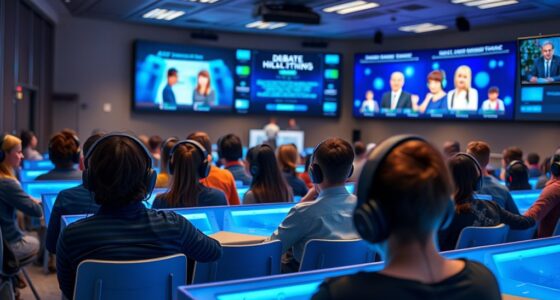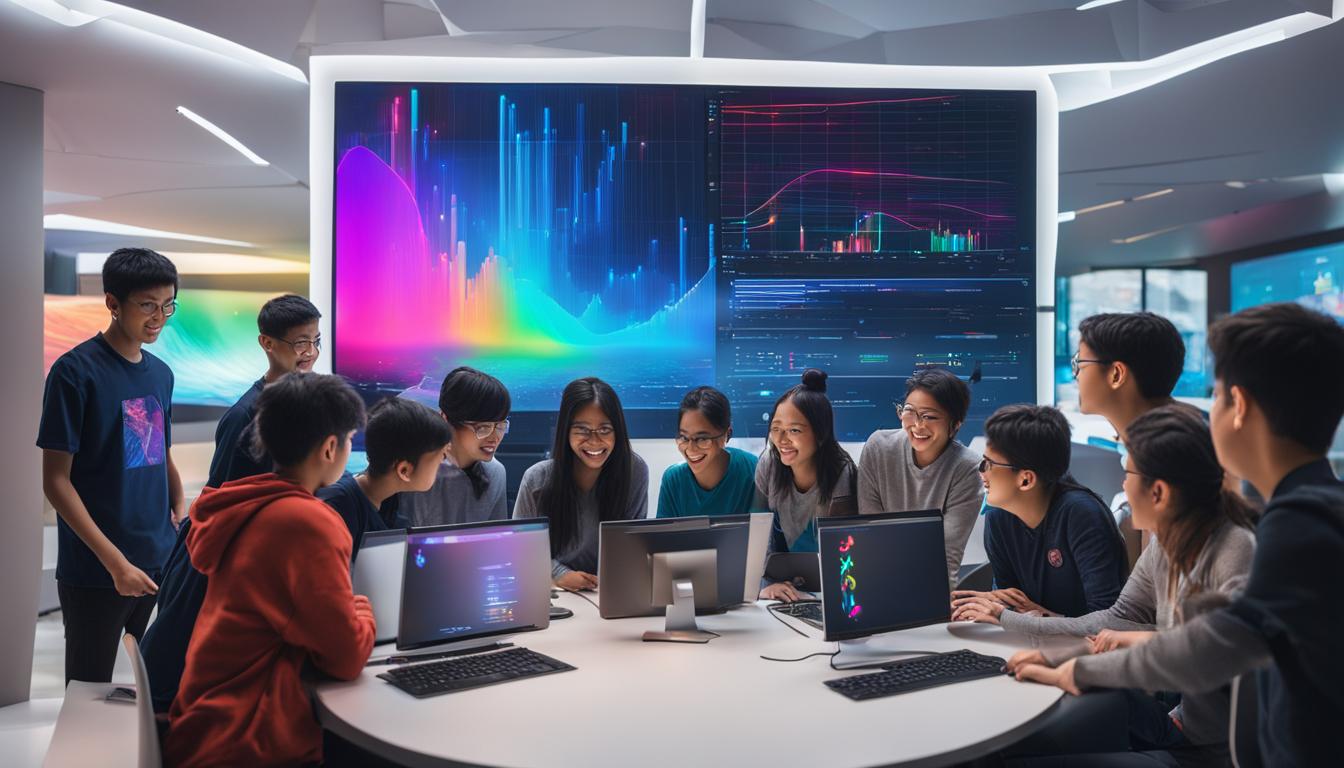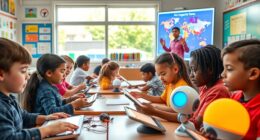Are you looking to revolutionize your approach to education? We’ve got you covered with 13 powerful strategies for accomplishing success in personalized learning.
Get ready to break free from the traditional classroom mold and discover new ways to engage and empower your students.
From flexible learning environments to adaptive technology tools, we’ll show you how to create a truly personalized experience that fosters growth and achievement.
Join us on this exciting journey towards liberation and watch your students thrive like never before.

Key Takeaways
- Implementing flexible learning environments with adaptable classrooms and movable furniture promotes collaboration and active engagement.
- Incorporating adaptive technology tools enhances individualization in learning paths and provides targeted instruction and support.
- Utilizing learner profiles for individualized instruction tailors instruction to specific needs and interests and identifies areas where students need additional support or challenge.
- Promoting student choice and voice empowers students to make choices in their learning, express their own voices, and creates a personalized curriculum based on individual needs and interests.
Implementing Flexible Learning Environments
Our school’s implementation of flexible learning environments has been a key factor in our personalized learning success. With a focus on flexible classroom design and student-centered instruction, we’ve created an environment that allows for individualized learning experiences.
Our classrooms are designed to be adaptable, with movable furniture and resources that can be easily rearranged to accommodate different learning needs. This flexibility promotes collaboration and active engagement among students, fostering a sense of ownership and empowerment in their education.
Additionally, our teachers utilize student-centered instructional strategies, such as project-based learning and personalized goal setting, to ensure that each student’s unique strengths and interests are addressed.
Incorporating Adaptive Technology Tools
When it comes to personalized learning, incorporating adaptive technology tools can have significant benefits.

These tools can adapt to individual student needs, providing targeted instruction and support.
Benefits of Adaptation
Using adaptive technology tools enhances the benefits of personalized learning, allowing us to tailor instruction and support to the unique needs and preferences of each learner. Here are three key benefits of incorporating adaptive technology tools into personalized instruction:
-
Individualization: Adaptive technology tools enable us to create individualized learning paths for each student. By analyzing data on their progress, strengths, and areas for improvement, we can provide targeted instruction and resources that meet their specific needs and learning styles.
-
Engagement: Adaptive technology tools offer interactive and dynamic learning experiences. These tools can adapt to students’ progress and provide immediate feedback, keeping them engaged and motivated to learn.

-
Autonomy: With adaptive technology tools, learners have more control over their learning journey. They can set their own pace, access resources at their convenience, and receive personalized support when needed. This autonomy fosters a sense of ownership and empowerment in the learning process.
Incorporating adaptive technology tools into personalized instruction not only enhances learning outcomes but also promotes self-directed and meaningful learning experiences.
Effective Implementation Techniques
To maximize the benefits of incorporating adaptive technology tools into personalized instruction, we must focus on effective implementation techniques.
Implementing personalized strategies requires careful planning and consideration. It’s essential to start by assessing the needs and goals of each learner. This will help in selecting the appropriate adaptive technology tools that align with their individual learning styles and preferences.

Once the tools are chosen, it’s crucial to provide thorough training and support to educators to ensure they can effectively integrate these tools into their instruction.
Additionally, ongoing monitoring and evaluation of the implementation process are essential to make necessary adjustments and improvements.
Impact on Student Engagement
Incorporating adaptive technology tools significantly enhances student engagement throughout personalized learning. With the use of these tools, students are more motivated to actively participate in their own education. Here are three ways in which adaptive technology tools impact student engagement:
-
Real-time feedback: Adaptive technology provides immediate feedback to students, allowing them to track their progress and make necessary adjustments. This instant feedback keeps students engaged and motivated to improve.

-
Personalized instruction: Adaptive technology tools can tailor the learning experience to meet each student’s individual needs. This personalized instruction keeps students engaged by presenting content in a way that’s relevant and meaningful to them.
-
Interactive learning experiences: Adaptive technology tools offer interactive features that make the learning process more engaging. Whether it’s through gamification, simulations, or interactive quizzes, these tools make learning enjoyable and encourage active participation.
Utilizing Learner Profiles for Individualized Instruction
We harness learner profiles to tailor instruction and enhance personalized learning experiences.
Learner profiles provide valuable insights into individual student needs, preferences, and learning styles. By understanding each student’s unique characteristics, we can create instructional strategies that address their specific needs and interests.

Learner preferences, such as their preferred modes of learning or topics of interest, can be incorporated into personalized lesson plans and activities. This allows students to engage more deeply with the content and take ownership of their learning.
Additionally, learner profiles help us identify areas where students may need additional support or challenge, enabling us to differentiate instruction accordingly.
Promoting Student Choice and Voice
One key strategy for personalized learning success is empowering students with the freedom to make choices and express their own voices. Student empowerment is essential in creating a personalized curriculum that caters to their individual needs and interests. By promoting student choice and voice, we allow students to take ownership of their learning journey and become active participants in the educational process.
Imagine a classroom where students have the power to select topics of study, decide how they want to demonstrate their understanding, and contribute their unique perspectives to class discussions. This approach not only fosters a sense of autonomy and engagement but also encourages critical thinking and creativity. By giving students the freedom to make choices and express their voices, we create an environment where learning becomes a liberating experience.

Now, let’s explore how providing personalized feedback and assessments further enhances the effectiveness of personalized learning.
Providing Personalized Feedback and Assessments
When it comes to providing personalized feedback and assessments, there are two key points to consider: effective feedback techniques and assessment for individual progress.
By using a variety of feedback strategies, such as timely and specific comments, we can help students understand their strengths and areas for improvement.
Additionally, implementing assessments that focus on individual progress rather than just grades allows us to tailor instruction to meet each student’s unique needs.

Effective Feedback Techniques
To maximize student learning, educators must employ targeted feedback techniques to provide personalized assessments and guidance. Effective feedback is crucial in improving communication and promoting growth in a personalized learning environment.
Here are three powerful feedback techniques that can enhance student learning:
-
Frequent check-ins: Regularly meeting with students allows educators to understand their progress, address concerns, and provide timely guidance.
-
Specific and actionable feedback: Providing feedback that’s specific and actionable helps students understand their strengths and areas for improvement, enabling them to make meaningful progress.

-
Self-assessment and reflection: Encouraging students to reflect on their own learning and assess their progress empowers them to take ownership of their education and set goals for growth.
Assessment for Individual Progress
To ensure personalized learning success, we continue our discussion by exploring assessment for individual progress, which involves providing personalized feedback and assessments.
Learner evaluations play a crucial role in this process, as they allow educators to gauge each student’s understanding and tailor instruction accordingly. By collecting data on students’ strengths, weaknesses, and learning preferences, personalized assessments can be created to measure individual progress effectively.
These assessments can take various forms, such as quizzes, projects, or portfolios, allowing students to demonstrate their knowledge and skills in ways that resonate with their unique abilities.

The feedback provided through these assessments is crucial for students to understand their areas of improvement and make informed decisions about their learning journey. By incorporating personalized assessments and providing targeted feedback, educators can empower learners to take ownership of their education and make meaningful progress.
Encouraging Collaborative Learning Opportunities
At our school, we prioritize fostering collaborative learning opportunities through the use of group projects and interactive discussions. We believe that collaborative projects and peer learning not only enhance students’ understanding of the subject matter but also promote critical thinking and communication skills.
Here are three ways we encourage collaborative learning:
-
Project-Based Learning: Our students engage in collaborative projects that require them to work together towards a common goal. This allows them to develop problem-solving skills and learn from each other’s strengths and weaknesses.

-
Interactive Discussions: We facilitate interactive discussions where students share their perspectives and engage in respectful debates. This encourages active participation and helps students develop their communication and listening skills.
-
Peer Feedback: Students provide constructive feedback to their peers, fostering a culture of support and growth. This feedback helps students refine their ideas and improve their work.
Differentiating Instruction Based on Student Needs
We prioritize meeting the diverse needs of our students by differentiating instruction based on their individual learning styles and abilities. Personalized learning strategies and differentiated instruction techniques play a crucial role in ensuring that every student can thrive in the classroom. By tailoring our teaching methods to suit the specific needs of each student, we create a learning environment that is inclusive and supportive. To illustrate the importance of differentiating instruction, consider the following table:
| Learning Style | Differentiated Instruction Technique | Benefits |
|---|---|---|
| Visual | Use of diagrams, charts, and graphs | Enhances understanding and retention |
| Auditory | Verbal instructions and discussions | Facilitates comprehension through listening |
| Kinesthetic | Hands-on activities and experiments | Promotes active learning and engagement |
Fostering Self-Paced Learning Experiences
When it comes to fostering self-paced learning experiences, there are several key points to consider.

First, student autonomy in learning is crucial, as it allows students to take ownership of their education and progress at their own pace.
Additionally, personalized learning pathways can be implemented to provide students with individualized instruction and resources that cater to their specific needs.
Student Autonomy in Learning
In order to foster self-paced learning experiences, educators must prioritize students’ autonomy in the learning process. By promoting student motivation and independent learning, we empower students to take ownership of their education and explore their interests at their own pace.
Here are three strategies to cultivate student autonomy:

-
Choice-based assignments: Allowing students to choose topics or projects that align with their passions and strengths promotes intrinsic motivation and engagement.
-
Self-assessment opportunities: Encouraging students to reflect on their learning progress and set goals for improvement cultivates a sense of responsibility and self-directedness.
-
Flexible pacing: Providing students with the opportunity to progress through content at their own speed ensures that they can fully grasp concepts before moving on, boosting comprehension and confidence.
Personalized Learning Pathways
To foster self-paced learning experiences, our approach focuses on creating personalized learning pathways. These pathways are designed to cater to the unique needs and interests of each individual learner.

We start by conducting personalized learning assessments to gain a comprehensive understanding of each student’s strengths, weaknesses, and learning styles. Based on the assessment results, we create customized learning pathways that allow students to progress at their own pace.
This approach empowers students to take ownership of their learning journey and encourages them to overcome personalized learning challenges. By providing students with the flexibility to move through the material at their own speed, they can delve deeper into topics of interest or spend more time on challenging concepts.
This self-pacing approach promotes a sense of autonomy and independence, fostering a love for learning and maximizing student success. As we delve into the benefits of self-pacing, it becomes clear how this approach can revolutionize education.
Benefits of Self-Pacing
We often find that self-pacing fosters personalized learning experiences, empowering us to tailor our educational journey to our unique needs and interests. The benefits of self-pacing are numerous and can greatly enhance the effectiveness of our learning process.

-
Flexibility: Self-pacing allows us to set our own pace and work at our own speed, accommodating different learning styles and preferences.
-
Mastery: With self-pacing, we’ve the opportunity to focus on areas where we need more time and practice, ensuring a deeper understanding and mastery of the subject matter.
-
Autonomy: Self-pacing gives us the freedom to take control of our own learning, making choices about what, when, and how we learn.
Leveraging Data to Drive Personalized Instruction
Our data-driven approach enhances personalized instruction, allowing us to tailor learning experiences to individual student needs. By leveraging analytics, we gather valuable insights into students’ progress, preferences, and areas of improvement.

This data empowers us to identify patterns and trends, enabling us to make informed decisions about personalized interventions. We can provide targeted support and resources to students who may be struggling in specific areas, while challenging those who are ready for more advanced concepts.
Our data-driven approach ensures that each student receives the right level of instruction at the right time, maximizing their learning potential.
As we transition into the next section about cultivating a growth mindset in learners, it’s important to recognize that our data-driven approach is just one piece of the puzzle in creating a holistic and empowering learning environment.
Cultivating a Growth Mindset in Learners
How can we foster a growth mindset in learners?

Here are three powerful techniques to cultivate a growth mindset in personalized learning:
-
Embrace challenges:
Encourage learners to view challenges as opportunities for growth. Teach them to persist, learn from setbacks, and see failure as a stepping stone towards success. This mindset helps learners develop resilience and a love for learning. -
Promote a positive learning environment:
Create an environment that celebrates effort, progress, and improvement. Encourage learners to support and learn from each other, fostering collaboration and a sense of community. -
Provide constructive feedback:
Offer specific and constructive feedback that focuses on effort, strategies, and growth. This helps learners understand that their abilities can be developed through dedication and hard work.
Supporting Student Goal-Setting and Reflection
To support student goal-setting and reflection, we encourage learners to actively engage in self-assessment and identify their personal learning objectives. By taking ownership of their learning process, students become more motivated and invested in their education.
Self-assessment allows students to reflect on their strengths and areas for improvement, enabling them to set realistic and attainable goals. This process helps students develop a growth mindset, where they believe that effort and perseverance lead to success.
When students have a clear understanding of their learning objectives, they’re more likely to stay focused and motivated throughout their educational journey. By regularly reflecting on their progress and adjusting their goals as needed, students can track their growth and celebrate their achievements.
Supporting student goal-setting and reflection is essential for fostering student motivation and ensuring goal attainment.

Engaging Families and Communities in Personalized Learning
Engaging families and communities in personalized learning strengthens the support network and enhances the learning experience for all stakeholders involved.
When parents are actively engaged in their child’s education, they become partners in the learning process. This involvement creates a sense of shared responsibility and empowers parents to support their child’s personalized learning journey.
Community involvement also plays a critical role in personalized learning success. By collaborating with local organizations and businesses, schools can provide real-world learning experiences and connect students with mentors in their fields of interest.
Additionally, community members can contribute their expertise and resources to enrich the curriculum and provide opportunities for students to apply their learning in meaningful ways.

Through engaging parents and involving the community, personalized learning becomes a collective effort that promotes student growth and liberation.
Addressing Equity and Access in Personalized Learning Environments
We strive to ensure equitable access to personalized learning environments by addressing disparities and providing opportunities for all students.
However, it’s important to acknowledge the equity challenges that exist in implementing personalized learning. One major challenge is the digital divide, which refers to the unequal distribution of technology resources among students. Some students may not have access to the necessary devices or internet connectivity at home, limiting their ability to fully participate in personalized learning activities.
To address this issue, schools and districts can consider providing devices and internet access to students who need them, as well as partnering with community organizations to bridge the digital divide.

Additionally, educators can design personalized learning experiences that don’t solely rely on technology, ensuring that all students have the opportunity to engage and succeed.
Frequently Asked Questions
How Can Personalized Learning Environments Address Equity and Access for All Students?
Personalized learning environments can address equity and access for all students by providing tailored instruction, resources, and support based on individual needs. This fosters inclusion and ensures that every student has an equal opportunity to succeed.
What Strategies Can Be Used to Engage Families and Communities in Personalized Learning?
To engage families and communities in personalized learning, we focus on building strong relationships, fostering open communication, and involving them in decision-making. By doing so, we create a collaborative environment that supports student success and promotes equity and access for all.
How Can Data Be Leveraged to Drive Personalized Instruction?
Leveraging data is crucial for instructional personalization. We analyze student performance, track progress, and identify areas for growth. This helps us tailor instruction to meet individual needs, leading to better learning outcomes for all.

What Are Some Ways to Foster a Growth Mindset in Learners?
To foster a growth mindset in learners, we cultivate motivation by providing meaningful challenges and celebrating progress. Building resilience involves teaching problem-solving skills and encouraging a positive attitude towards failure, viewing it as an opportunity for growth.
How Can Personalized Feedback and Assessments Be Provided to Students?
We provide timely feedback to students by utilizing digital tools. This helps us personalize their learning experience and ensure they receive the support they need to succeed.
Conclusion
In conclusion, implementing personalized learning strategies can greatly benefit students by tailoring their education to their individual needs and preferences.
For example, a case study found that a high school student who struggled with traditional classroom instruction thrived when given the opportunity to choose his own learning activities and set his own goals.

By incorporating flexible environments, adaptive technology, and personalized feedback, educators can create a more engaging and effective learning experience for all students.











